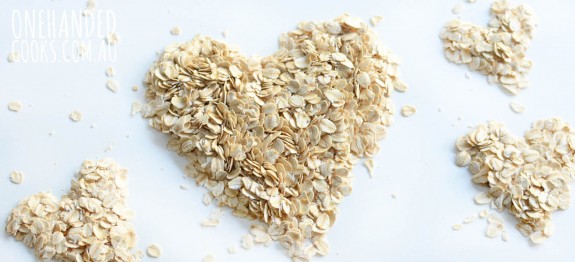We Heart Oats: Pantry Staple & Everyday Superfood
Oats are an extremely nutritious, versatile and cheap addition to your family’s diet. When made into porridge they are like a warm winter cuddle perfect for the colder months. Oats are also satisfying added to a fruit smoothie in summer – using seasonal fresh berries for breakfast, or a healthy ingredient in homemade high fibre snacks for your busy toddler all year round.
In Australia oats are increasingly grown for human consumption. They have a long list of health benefits important for both the young and the old making them an important addition to your shopping list.
Types of Oats:
Most people will be familiar with traditional or quick cooking rolled oats but there is actually quite the range of oats available in your supermarket or health food store.
- Groats: First there were groats. They are the unbroken and unflattened grain of the oat, only the husk has been removed. They are usually roasted at a low temperature giving oats their nice nutty flavour and long shelf life. Use in cooking: Chewy & nutty porridge, a substitute to rice or pasta.
- Steel Cut: The groat has been cut into pieces using a steel cutter. They are typically used to make porridge and retain much of their shape and have a chewy texture. Steel-cut oats however do take longer to cook than rolled oats, around 15-20 minutes in total. Use in cooking: Porridge, a substitute to rice, added to soups and salads.
- Rolled or “Traditional”: The most common oat variety in Australia, the groat is steamed, flattened between rollers then dried. They reabsorb water and cook more quickly then steel cut oats. Use in cooking: Porridge, muesli, baking.
- Quick Oats: Another popular variety, these are rolled oats that have been steamed longer and flattened thinner meaning they cook faster and have softer texture. Use in cooking: Porridge.
- Instant: Flattened even thinner than quick oats, they are chopped in to small pieces and often precooked to further reduce cooking time. Use in cooking: Porridge.
- Oat Bran: Oat bran can be removed from omes from the fibre-rich layer of cells located under the oat husk. Use in cooking: Baking, and used in the manufacturing of breads and cereals to increase their fibre content.
Always a Whole Grain:
Oats rarely have their bran and germ layer removed so despite the amount of processing they might undergo they will still be a whole grain. The Grains & Legumes Nutrition Council in Australia recommend the following whole grain daily targets for chronic disease prevention:
- 2-3 years: 24 g whole grains a day.
- 4-8 years: 32-40 g whole grains a day.
- 9+ years: 48 g whole grains a day.
Note: a 30 g serve (1/3 cup) of oats = 30 g whole grains.
Oats Have Layers:
Each of the 3 layers has its own nutrient profile providing a variety of vitamins and minerals.
Bran layer: The outer layer is rich in fibre, B vitamins and minerals.
Endosperm: The energy store provides carbohydrates, some protein and some B vitamins.
Germ: The inner store of nutrients includes B-vitamins, vitamin E, minerals and phytochemicals.
The Health Benefits of Oats
High in fibre, particularly soluble fibre, essential for bowel health and keeping you “regular”. A 30 g serve of rolled oats provides around 20% of the fibre requirements for a 1-3 year old, 15% for a 4-8 year old and 10% for an adult.
Carbohydrate rich and low GI* providing sustained energy for kids to run, play and learn. (*traditional oats have a low GI vs quick oats which have a medium GI).
Rich in beta-glucan, a soluble fibre known to actively lower cholesterol levels making for a healthy heart.
Contain health promoting phytochemicals and antioxidants including avenathramides, unique to oats, which protect the blood vessels from the harmful effects of LDL (bad) cholesterol.
High in B group vitamins, which are necessary for energy production in the body.
High in protein (11%) and fat (8-9%) oats provide energy and protein for healthy growth and development.
Naturally low in salt, essential for babies and toddlers.
NOTE: Beware of quick and instant oat varieties with added flavours, sugars and salt. It is best to avoid these. Instead stick with traditional/regular varieties and if you need to add flavour try fresh or stewed fruit, crushed nuts, a pinch of chia seeds or a tiny squeeze of honey.
A Note Relating to Oats and Coeliac Disease:
The inclusion of Oats as part of gluten free diet is often controversial.
The position statement from the Coeliac Society states, ‘the safety of oats in individuals with coeliac disease has been extensively investigated. Some people with coeliac disease exhibit toxicity to oats. The Clinical Advisory Committee of the Coeliac Research Fund recommends that in Australia and New Zealand, oats should be excluded from a gluten free diet for people with coeliac disease.’
However there may be some cases where the health benefits of oats outweigh the potential risks. It is essential that the decision to include oats as part of a gluten free diet be made in conjunction with a medical practitioner and dietitian experienced in the management of coeliac disease.
Our Favourite Oat Recipes:
Snacks:
Breakfast:
Join us on Facebook for other foodie bits and pieces.




























